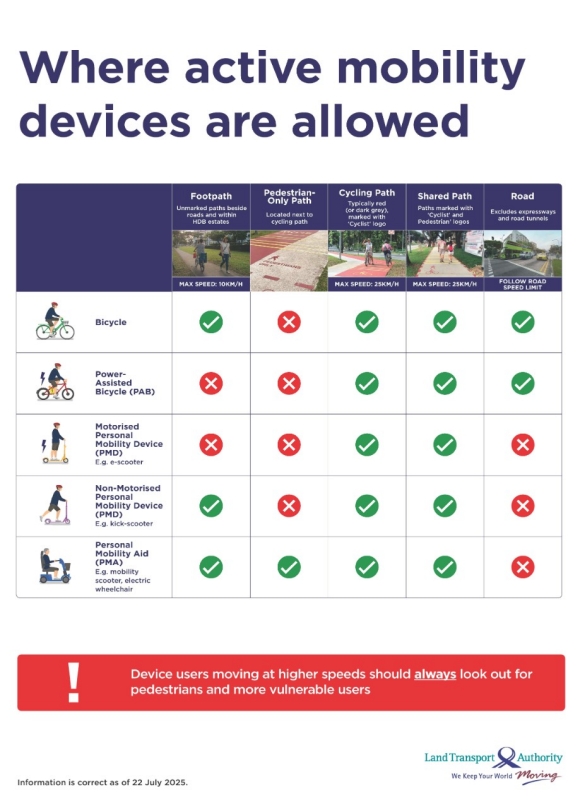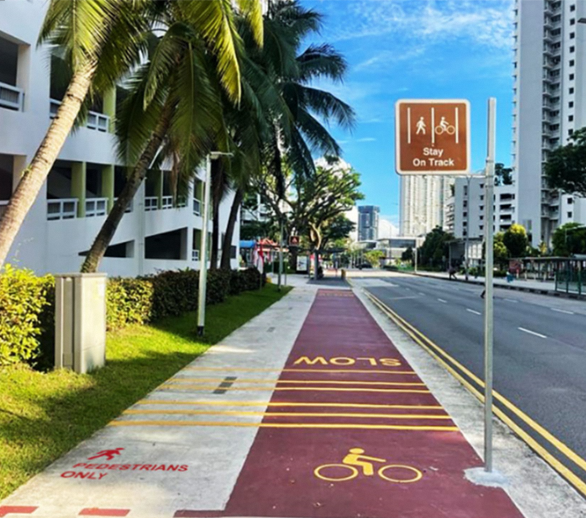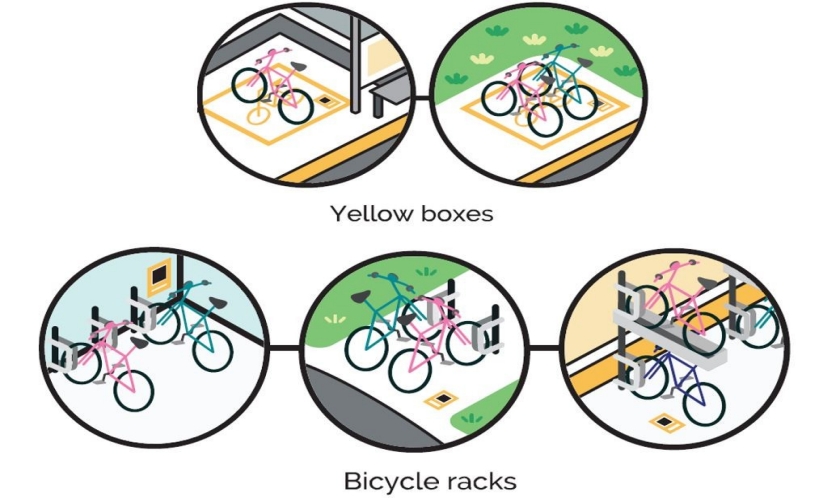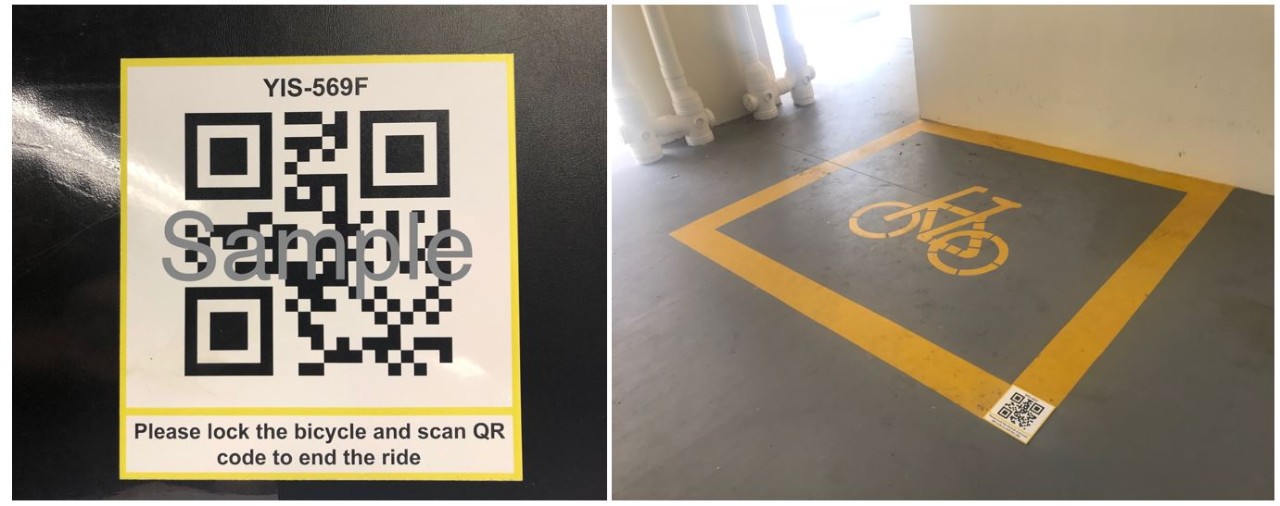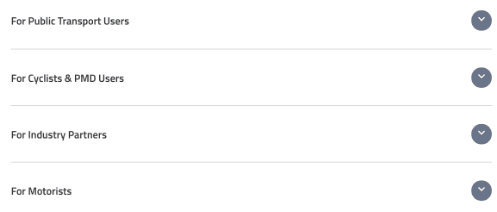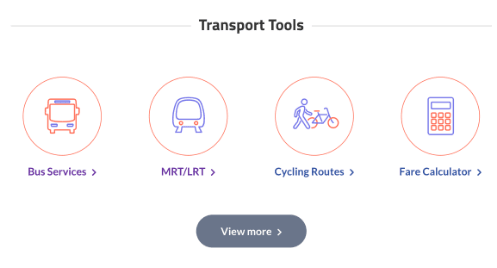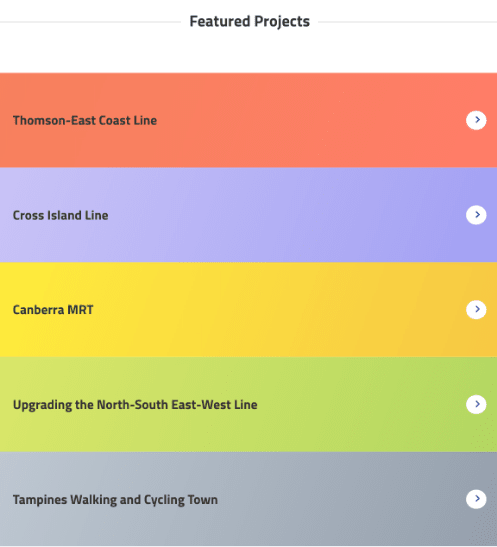Ensure your active mobility device meets these requirements before riding them on public paths and roads:
For Manual Bicycles and Three-wheeled Pedal Cycles
On public paths:
- Maximum weight of 20kg
- Maximum width of 70cm
- At least one functioning handbrake is required to be installed at the handlebar of the device
On roads:
- Maximum width of 130cm
- Maximum length of 260cm
- At least one functioning handbrake is required to be installed at the handlebar of the device
For Manual Recumbents
On public paths:
- Maximum weight of 20kg
- Maximum width of 70cm
- At least one functioning brake operated by the rider's hand(s) or feet
On roads:
- Maximum width of 130cm
- Maximum length of 260cm
- At least one functioning brake operated by the rider's hand(s) or feet
- A bright-coloured flag on a pole of a reasonable height
For Motorised Personal Mobility Devices (PMDs) and E-scooters
- Maximum weight of 20kg
- Maximum width of 70cm
- Maximum motorised device speed of 25km/h to ensure users do not exceed the speed limit
- Certified to the UL2272 device safety standard (PDF, 284kB), which is listed on LTA's whitelist (PDF, 1.9MB) to address fire risks and improve public safety1
- New e-scooters to be sold or let hire by retailers/companies are required to pass a Registration Inspection and must be registered with LTA. Before purchasing an e-scooter, ensure that it is registered with LTA and that the transfer of ownership of the e-scooter is completed upon purchase.
- Registered e-scooters will be called up for periodic inspection every 2 years to ensure that they remain compliant with LTA’s device criteria for use on public paths. E-scooters that do not pass inspection will be deregistered by LTA.
- Registered e-scooters should have a unique registration number and an LTA-issued registration mark displayed on the e-scooter. The registration mark should be affixed intact at the front or at the sides of your e-scooter stem, and must be upright, intact, unobscured, and not void/damaged.
- Individuals under 16 years old must not ride an e-scooter on cycling paths, unless they are supervised by an adult who is at least 21 years old. Those who intend to supervise an individual below 16 years old to ride an e-scooter must familiarise themselves with the guidelines of a supervisor (PDF, 177kB)
- E-scooter riders are required to pass the mandatory theory test for e-scooter before they are able to ride on cycling paths. Find out more details on the test formats and e-handbooks (PDF, 147kB)
1Please note that motorised luggage (PDF, 118kB) are considered as motorised PMDs (i.e. e-scooter), and will have to comply with the device criteria for motorised PMDs, including certification to the UL2272 device safety standard, and registered with LTA before they can be ridden on cycling paths.
For Power Assisted Bicycles (PABs)
- Maximum weight of 20kg
- Maximum width of 70cm when riding on public paths, or 130cm when riding on roads
- Maximum length of 260cm when riding on roads
- Type-approved, sealed and registered at an LTA-Authorised Inspection Centre, and that it bears a registration plate on the rear of the PAB. Find out more about the registration process of PAB and the list of type-approved PAB models (PDF, 2.6MB).
- Comply with European Standard, EN15194
- Motor power of the PAB must be progressively reduced and finally cut off as the bicycle reaches 25km/h, or sooner, if the cyclist stops pedalling
- View the list of technical requirements of PAB
- PAB riders who are under 16 years old must not ride PABs on cycling paths and roads, even if they are supervised by an adult
- PAB riders must not carry a passenger on a PAB on cycling paths and roads, if the passenger is under 16 years old
- PAB riders are required to pass the mandatory theory test for PAB before they are able to ride on cycling paths and on roads. Find out more details on the test formats and e-handbooks (PDF, 147kB)
For Personal Mobility Aids (PMAs) (Manual Wheelchairs, Motorised Wheelchairs and Mobility Scooters)
- A mobility scooter must satisfy the following:
(a) Has 3 or more wheels and a footboard supported by the wheels;
(b) Is steered by handlebars;
(c) Has only one seat (i.e. devices with multiple seats are not considered mobility scooters);
(d) Is designed to carry only one individual who is unable to walk or has difficulties walking; and
(e) Is propelled by a motor that forms part of the vehicle.
- From 2026,
(a) All motorised PMAs must not go above 6km/h on paths
(b) All PMAs used on public paths must comply with the following dimension restrictions (which currently apply on public transport):
- Width: 70cm
- Length: 120cm
- Height: 150cm
- Laden Weight: 300kg
- Users who require PMAs beyond the allowable dimensions will be exempted from the device dimension requirements on public paths if their need to use an oversized device is certified by a healthcare professional through the Assessment for Mobility Scooter (AMS)
(c) Mobility scooter users must obtain a certification of medical need through the AMS. See section on "Certification of Medical Need for Mobility Scooter Users" for more details
(d) Retailers are not allowed to display, advertise or sell PMAs with maximum speeds exceeding 6km/h, and/or PMAs that exceed the new device dimensions restrictions
- Existing motorised PMAs with maximum speed up to 10km/h can continue to be used until end-2028, but must travel no faster than 6km/h on paths. From 2029, all PMAs must not have a maximum speed exceeding 6km/h
Know the differences between mobility scooters and their lookalikes (PDF, 365kB), and ensure you only purchase compliant active mobility devices1.
1 Check out the Notice on New Regulations on PMAs (PDF, 223kB) before making any purchase.
Owners of motorised devices (motorised PMDs, PABs and PMAs) should refrain from using non-original batteries, which may pose fire risks. See the accompanying infographic on safe charging practices for motorised devices (JPG, 302kB) and fire safety tips (JPG, 142kB).




